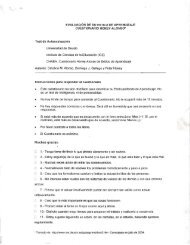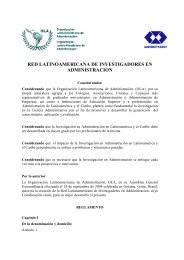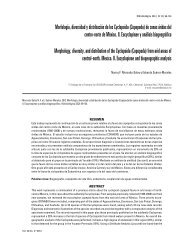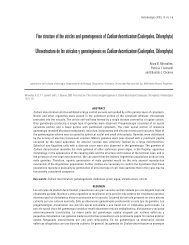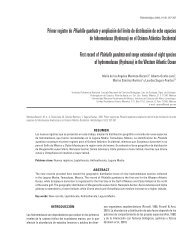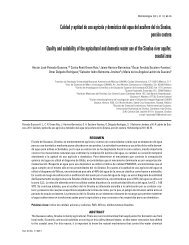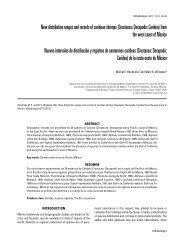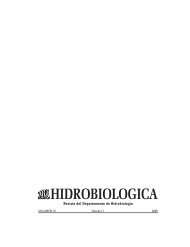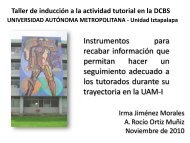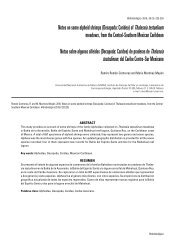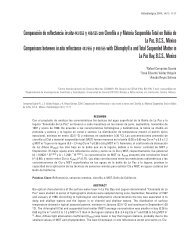LCD pixel shape and far field diffraction patterns - Páginas de ...
LCD pixel shape and far field diffraction patterns - Páginas de ...
LCD pixel shape and far field diffraction patterns - Páginas de ...
Create successful ePaper yourself
Turn your PDF publications into a flip-book with our unique Google optimized e-Paper software.
268ARTICLE IN PRESSM. Fernán<strong>de</strong>z Guasti et al. / Optik 116 (2005) 265–269Fig. 4. Diffraction pattern of squircle with s ¼ 0:9; contourplot for iso-amplitu<strong>de</strong>s shown on the top <strong>and</strong> 3D mesh withheight representing the <strong>field</strong> amplitu<strong>de</strong> on the bottom.Fig. 5. Image of a single <strong>LCD</strong> <strong>pixel</strong> (top) <strong>and</strong> the corresponding<strong>diffraction</strong> pattern in the <strong>far</strong> <strong>field</strong> (bottom).frequencies on the aperture have stronger influence onhigher-or<strong>de</strong>r rings or further away from the axis in the<strong>diffraction</strong> pattern [7].Let us now exhibit the images <strong>and</strong> <strong>diffraction</strong> <strong>patterns</strong>obtained with the <strong>LCD</strong> mask. The microscope image ofa single <strong>LCD</strong> <strong>pixel</strong> together with its <strong>far</strong>-<strong>field</strong> <strong>diffraction</strong>pattern is shown in Fig. 5. The low resolution of thetraveling microscope yields an image whose squarish<strong>shape</strong> may only be approximately guessed from thephotograph. However, comparison of the <strong>diffraction</strong>pattern of the <strong>pixel</strong> with the previous <strong>patterns</strong> showsthat the <strong>pixel</strong> is not a perfect square with sharp corners.The most similar <strong>diffraction</strong> image is 3c, which indicatesthat the <strong>pixel</strong> has blunt corners with a squarenessparameter around s ¼ 0:9: The reference wavefront in aPDI will have this pattern when implemented with an<strong>LCD</strong> <strong>pixel</strong> of this type. Departure from the point sourcecircular symmetry is expected even if only the centralportion is consi<strong>de</strong>red as may be seen from the contourplot in Fig. 4. This discrepancy with the sphericalwavefront should then be taken into account so that it isnot associated, for example, with aberrations of anoptical system un<strong>de</strong>r test.In Fig. 6, the image <strong>and</strong> <strong>diffraction</strong> pattern of anarray of nine apertures are shown. The contribution ofthe square <strong>pixel</strong>s blunt corners is still clear in the<strong>diffraction</strong> pattern. On the one h<strong>and</strong>, full rings ratherthan the spots expected from the square array are clearlyvisible. On the other h<strong>and</strong>, the rings are not circular butare flattened at 45 from the Cartesian axes. Furthermore,the rings are more intense in the regions whereperfect squares would exhibit their maxima. The<strong>diffraction</strong> pattern, according to Fourier optics theory,should correspond to the convolution of the single <strong>pixel</strong>aperture that is shifted to the other eight positions in theaperture plane.5. ConclusionsThe <strong>far</strong>-<strong>field</strong> <strong>diffraction</strong> from apertures whose <strong>shape</strong>lies between a square <strong>and</strong> a circle has been experimentallystudied. The main features of the observed<strong>diffraction</strong> <strong>patterns</strong> are qualitatively in accordance withpreviously reported computer simulations. From atopological point of view, these results no longer exhibitthe square <strong>and</strong> the circle as isolated aperture cases but asa continuous <strong>de</strong>formation, which may be tackled withnumerical evaluations that can be qualitatively comparedwith experimental observations.


